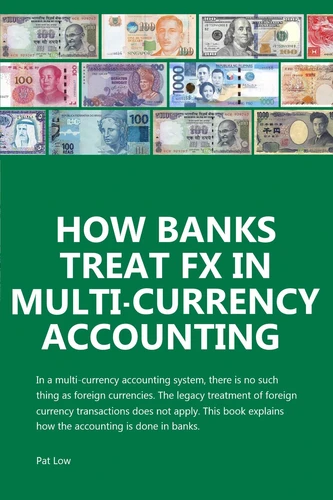How Banks Treat FX In Multi - Currency Accounting
Par :Formats :
Disponible dans votre compte client Decitre ou Furet du Nord dès validation de votre commande. Le format ePub est :
- Compatible avec une lecture sur My Vivlio (smartphone, tablette, ordinateur)
- Compatible avec une lecture sur liseuses Vivlio
- Pour les liseuses autres que Vivlio, vous devez utiliser le logiciel Adobe Digital Edition. Non compatible avec la lecture sur les liseuses Kindle, Remarkable et Sony
 , qui est-ce ?
, qui est-ce ?Notre partenaire de plateforme de lecture numérique où vous retrouverez l'ensemble de vos ebooks gratuitement
Pour en savoir plus sur nos ebooks, consultez notre aide en ligne ici
- FormatePub
- ISBN8223580263
- EAN9798223580263
- Date de parution19/05/2023
- Protection num.pas de protection
- Infos supplémentairesepub
- ÉditeurDraft2Digital
Résumé
What is multi-currency accounting? Why do banks use this instead of the legacy single currency system?Traditional way of recognising foreign currency transactions in a base currency of account cannot support the needs of entities operating in an environment of fast moving and massive turnover transactions in multiple currencies. These entities are primarily in the financial services industry. Banks, for example, handle huge volumes of foreign exchange deals in multiple currencies and in wholesale-sized transactions daily.
The front office monitors currency risk exposures by the seconds. The middle office keeps daily vigil on realised exchange gains or losses, and valuations on their massive FX carry trades and open cash positions. The impact of changing exchange rates is a much discussed topic in the accounting profession. It has taken years for IAS21 to be finalised. Throughout all these dialogues over the years, multi-currency accounting has been the elephant in the room.
Find out how banks employ multi-currency accounting systems to handle this matter in an entirely different manner. "How Banks Treat FX In Multi-Currency Accounting" explains the detailed debits and credits with easy-to-understand illustrations. It may surprise many that there is no such thing as foreign currencies in multi-currency accounting. This is a topic where there is a dearth of literature.
This is a book written from the trenches for those who appreciate practical experience.
The front office monitors currency risk exposures by the seconds. The middle office keeps daily vigil on realised exchange gains or losses, and valuations on their massive FX carry trades and open cash positions. The impact of changing exchange rates is a much discussed topic in the accounting profession. It has taken years for IAS21 to be finalised. Throughout all these dialogues over the years, multi-currency accounting has been the elephant in the room.
Find out how banks employ multi-currency accounting systems to handle this matter in an entirely different manner. "How Banks Treat FX In Multi-Currency Accounting" explains the detailed debits and credits with easy-to-understand illustrations. It may surprise many that there is no such thing as foreign currencies in multi-currency accounting. This is a topic where there is a dearth of literature.
This is a book written from the trenches for those who appreciate practical experience.
What is multi-currency accounting? Why do banks use this instead of the legacy single currency system?Traditional way of recognising foreign currency transactions in a base currency of account cannot support the needs of entities operating in an environment of fast moving and massive turnover transactions in multiple currencies. These entities are primarily in the financial services industry. Banks, for example, handle huge volumes of foreign exchange deals in multiple currencies and in wholesale-sized transactions daily.
The front office monitors currency risk exposures by the seconds. The middle office keeps daily vigil on realised exchange gains or losses, and valuations on their massive FX carry trades and open cash positions. The impact of changing exchange rates is a much discussed topic in the accounting profession. It has taken years for IAS21 to be finalised. Throughout all these dialogues over the years, multi-currency accounting has been the elephant in the room.
Find out how banks employ multi-currency accounting systems to handle this matter in an entirely different manner. "How Banks Treat FX In Multi-Currency Accounting" explains the detailed debits and credits with easy-to-understand illustrations. It may surprise many that there is no such thing as foreign currencies in multi-currency accounting. This is a topic where there is a dearth of literature.
This is a book written from the trenches for those who appreciate practical experience.
The front office monitors currency risk exposures by the seconds. The middle office keeps daily vigil on realised exchange gains or losses, and valuations on their massive FX carry trades and open cash positions. The impact of changing exchange rates is a much discussed topic in the accounting profession. It has taken years for IAS21 to be finalised. Throughout all these dialogues over the years, multi-currency accounting has been the elephant in the room.
Find out how banks employ multi-currency accounting systems to handle this matter in an entirely different manner. "How Banks Treat FX In Multi-Currency Accounting" explains the detailed debits and credits with easy-to-understand illustrations. It may surprise many that there is no such thing as foreign currencies in multi-currency accounting. This is a topic where there is a dearth of literature.
This is a book written from the trenches for those who appreciate practical experience.



